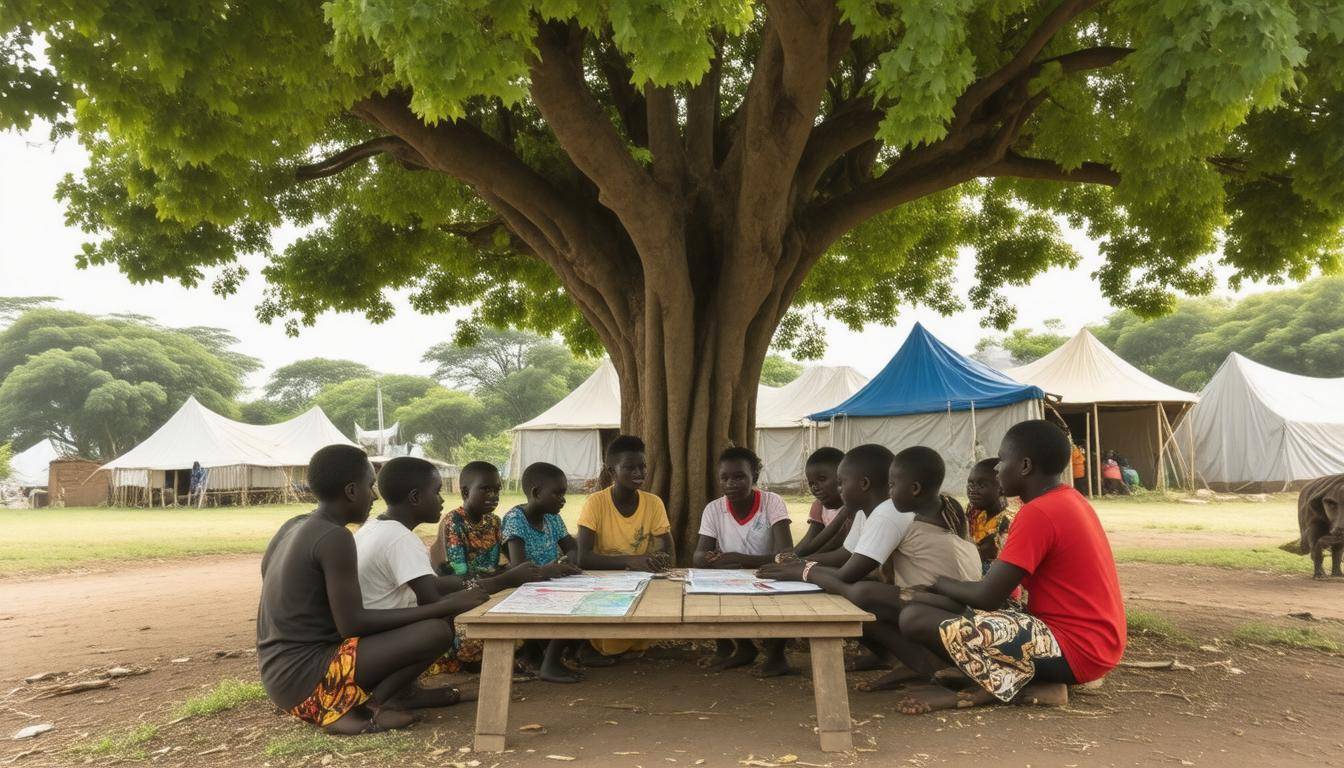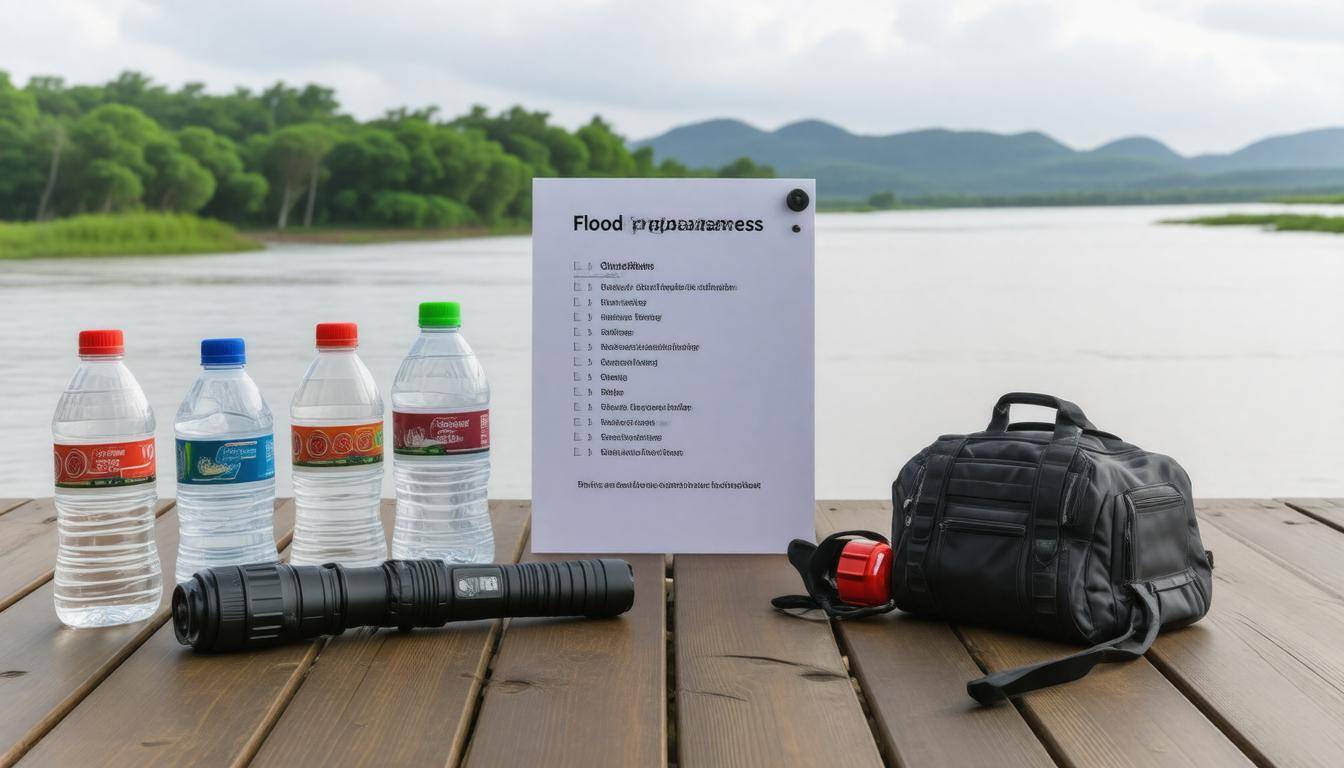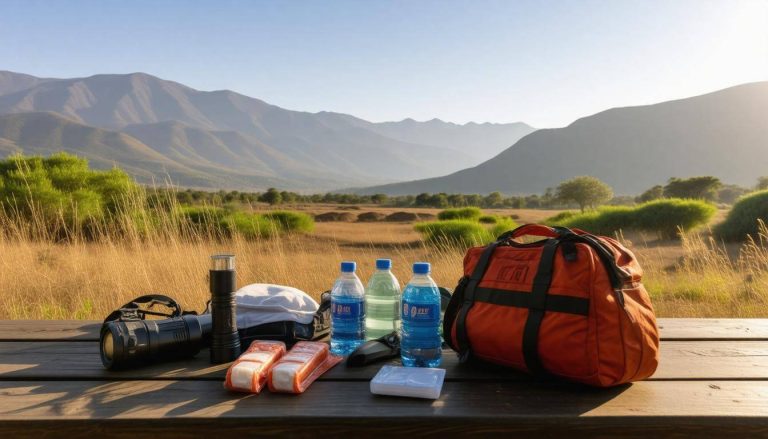When winter hits Alaska, it’s more than just cold; it’s a world of harsh conditions that can turn any outing into a potential survival scenario. If you’ve ever found yourself unprepared while facing biting winds or sudden snowstorms, you know how vital it is to be ready. It’s not just about staying warm; it’s about ensuring you have the right supplies to navigate whatever challenges come your way. From clothing to food and emergency gear, having a well-thought-out winter survival kit makes all the difference. This guide will walk you through everything you need to create an effective Alaska Winter Survival Kit so you can embrace the beauty of winter with confidence and safety.
The Alaska Winter Survival Kit should include essential items such as a sturdy metal-bladed shovel, heavy blankets and sleeping bags for warmth, non-perishable snacks and ample water for hydration, extra warm clothing including hats and gloves, and reflective vests for visibility during emergencies. Additionally, incorporating emergency lighting, a heating source like a plumber’s candle, roadside safety kits, and maintaining your vehicle properly are crucial components for winter preparedness.
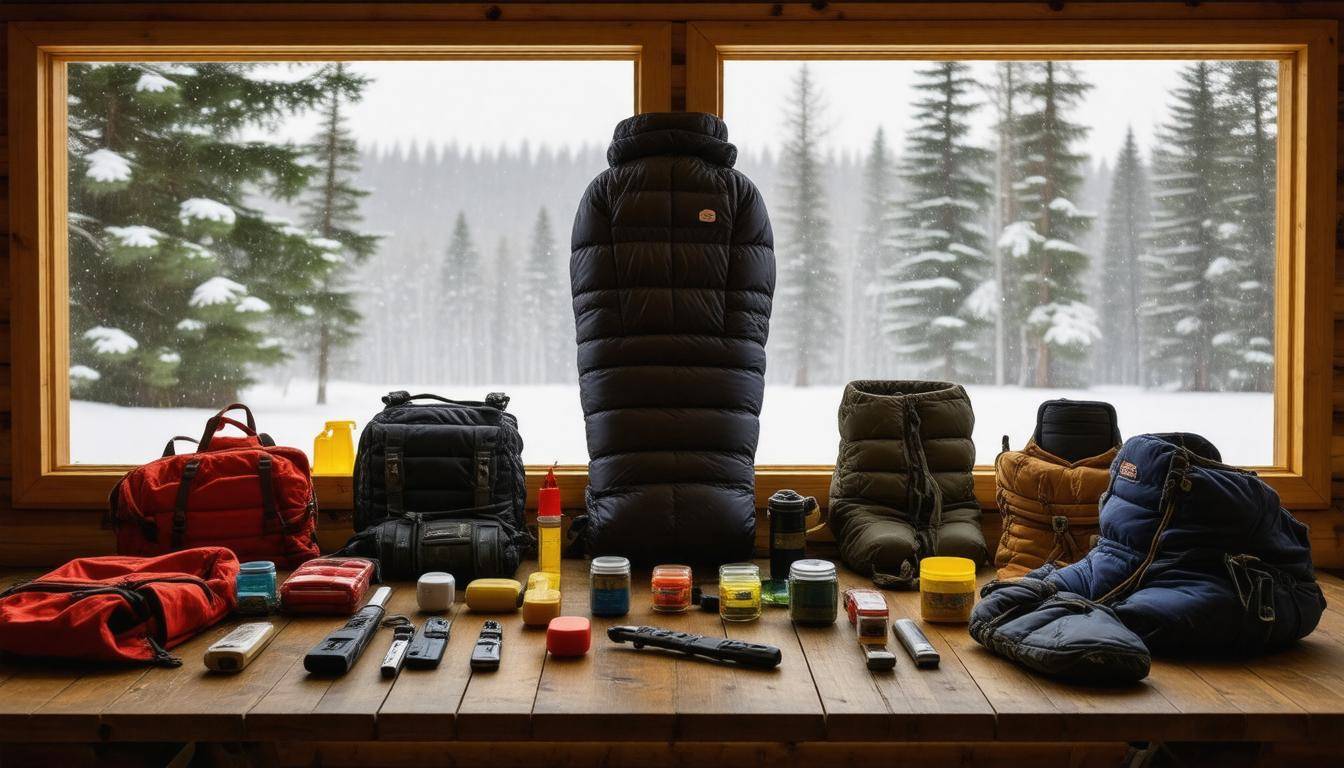
Clothing Essentials for Alaska Winters
The extreme cold in Alaska requires layers—not just any layers, but specifically designed garments that effectively trap heat while allowing moisture to escape. When you’re out in sub-zero temperatures, every item of clothing counts. Calling to mind the advice from seasoned Alaskans, the ideal layering system consists of at least three key components.
Base Layers
Start with base layers crafted from moisture-wicking materials such as merino wool or high-quality synthetic fabrics. These materials pull sweat away from your body, keeping you dry and warm. Cotton is a definite no-go; it retains moisture against your skin, making you colder as the icy winds whip by. Choose long-sleeve tops and bottoms that fit snugly against your skin without restricting movement— these are what provide the first line of defense against the cold.
Insulating Layers
Next comes insulation, and here’s where bulk can be your friend. Layering up with fleece pullovers or down jackets creates pockets of air that trap warmth. Synthetic insulated garments are also an excellent choice as they provide warmth even when damp. Think of this layer as your cozy barrier against the frigid air outside; it should comfortably allow you to move while maintaining your body heat. An insulating layer that’s breathable will save you from feeling too hot when you’re active—an often overlooked balance.
Outer Layers
Finally, you must top your ensemble with an outer shell that is both waterproof and windproof. Materials like Gore-Tex perform exceptionally well in guarding against snow and fierce winds bouncing off the mountains… that foggy morning might turn into a blizzard before you know it. This shell keeps all the hard work of your internal layers intact, ensuring that pesky snowflakes don’t turn into an unexpected chill seeping through.
Essential Items:
- Wool or synthetic base layers: Proven performers in moisture management.
- Fleece or down jackets: Effective insulators that can be compressed for packing.
- Waterproof outer shell: Always a smart investment against wet conditions.
- Thermal socks and gloves: Essential in keeping extremities warm.
- Insulating hats and balaclavas: Cap those warm layers off with headgear because so much heat escapes through your head!
Once your clothing setup is complete, it’s important to explore additional protective gear that enables safe and comfortable movement through these harsh conditions.
Key Gear for Extreme Cold
Beyond just having clothing to fight off the chill, investing in top-notch gear is essential for navigating the bone-numbing Alaskan winters. The right equipment isn’t merely a luxury; it can be the deciding factor between safety and peril in harsh situations.
For instance, boots are not just footwear; they are your lifeline against the elements. This is where high-quality insulated boots come into play. When choosing boots, look for renowned brands like Sorel or Baffin, known for their durability and insulation capabilities. A boot rated for -40°F or even lower ensures that your feet stay warm and dry, protecting you from frostbite and hypothermia.
Hand and Foot Warmers
Alongside sturdy boots, hand and foot warmers are often underestimated until you find yourself shivering uncontrollably at a roadside stop. These small packets might seem insignificant, but they can provide several hours of comforting warmth when temperatures plummet.
Easily portable, you can stash them in pockets or mittens, and activate them whenever needed. They become especially crucial if you’re stuck outdoors longer than planned, as they help stave off the cold that creeps in through your extremities.
Extreme Cold Sleeping Bags
Another key piece of gear that’s imperative is an extreme cold sleeping bag. When venturing into frigid conditions, having a sleeping bag rated for -30°F or lower isn’t just advantageous—it’s necessary.
In potentially life-threatening circumstances, it’s vital to have this gear on hand should you need to sleep outside or find refuge in an unheated shelter. A quality sleeping bag designed for extreme cold will often have added insulation features and will be crafted to minimize heat loss, ensuring you can rest safely even when temperatures dip dramatically.
Statistics reveal that exposure to extremely low temperatures without appropriate gear can lead to frostbite within just 30 minutes. Ahimsa promoting why equipping yourself with proper tools and gear is non-negotiable.
With these essential pieces of equipment secured, let’s now uncover how specific materials and designs contribute to ensuring safety and comfort when facing extreme conditions.
Shelter and Warmth Supplies
One of the most effective ways to protect yourself from the biting cold is by having a portable shelter that you can depend on. A well-constructed, all-weather tent can be your sanctuary amid harsh conditions. Look for tents made with durable, wind-resistant materials designed specifically for extreme weather. They should have a strong structure that can withstand heavy snowfall, as a flimsy tent will offer little comfort when the winds howl. Envision yourself escaping into that cozy haven while outside storms rage. It’s not just a luxury; it’s a lifeline.
Portable Shelter
While choosing your portable shelter, consider those tents that come with extra features like a snow skirt or reinforced seams. These elements provide added protection against penetrating cold and moisture. A tent rated for four seasons is often recommended, offering robust design to handle the most severe winter elements.
As you set it up in adverse conditions, you’ll find that the process becomes simpler with practice, allowing for quicker assembly when each second counts. Moreover, purchasing a larger tent can be advantageous if traveling with companions since it allows for some space to move and helps retain warmth.
Thermal Blankets and Sleeping Pads
The next layer of your warmth strategy involves thermal blankets and sleeping pads. Emergency thermal blankets are compact and lightweight; they reflect body heat back to you, serving as an excellent short-term defense against the chill. Many people underestimate how effective these blankets can be; a simple wrap can make all the difference in maintaining core warmth during emergency situations.
Besides thermal blankets, insulated sleeping pads should not be overlooked. These pads serve as crucial barriers between your body and the icy ground beneath. They are designed specifically to reduce heat loss through conduction, which can sap energy quickly when lying on frigid surfaces. When combined with your blanket, they create an insulating layer that locks warmth in while keeping cold at bay.
Portable Heaters
“I once got stranded during a snowstorm,” shared Alaskan resident John Doe. “My portable propane heater kept my tent warm enough for survival.” His experience highlights how portable heaters can be indispensable when unexpected situations arise. Investing in a reliable propane heater or wood stove allows significant heating without using excessive fuel or electricity—something especially vital in off-grid circumstances.
However, it’s important to use portable heaters safely within any enclosed space. Proper ventilation must always be maintained to avoid carbon monoxide buildup, which poses serious health risks. Hence, regularly checking your equipment before departure is equally essential as stocking your supplies.
Ensuring you have proper shelter and warmth is crucial but equally important is maintaining vital supplies to sustain energy and hydration during your adventure. Having such preparations in place enhances your ability to navigate the challenges posed by nature effectively.
Food and Water Storage

Maintaining proper nutrition and hydration during emergencies helps sustain energy levels and body temperature in those cold Alaskan winters. With temperatures dropping significantly, ensuring you have the right supplies can make all the difference in an unexpected situation. Imagine being stuck in your vehicle during a snowstorm; having adequate food and water can provide comfort and keep your spirits high.
Shelf-Stable Foods
Start by stocking up on shelf-stable foods such as protein bars, freeze-dried meals, and canned goods. What makes these items particularly handy is their long shelf life and minimal preparation needs. This means less worrying about cooking or heating meals when time is of the essence.
For instance, freeze-dried meals can be stored for years if kept in airtight packaging, making them a smart choice for your emergency kit.
By having easy-to-eat options like granola bars or energy bars, you can grab nourishment quickly without expending too much energy on meal prep—something that’s vital when every ounce of energy counts.
Water Storage
When it comes to hydration, use insulated containers to store water; this strategy prevents it from freezing even in harsh winter conditions. Aim to carry at least one gallon of water per person per day. If you find yourself near a natural water source during your travels, bringing along a portable water filter is invaluable. This will allow you to purify water from streams or lakes, ensuring you have access to clean drinking water when needed most.
Incorporating both methods provides redundancy: you have stored water as a primary source while also being empowered to find more in nature if necessary.
High-Calorie Snacks
Don’t forget about high-calorie snacks! Items such as nuts or chocolate are compact and provide quick energy boosts that can be incredibly valuable if you’re waiting for help or working hard to create warmth. They not only satisfy hunger but also help replenish calories rapidly.
Essential Items to Include:
- Insulated water containers: To keep liquids fluid in freezing temperatures.
- Protein bars and freeze-dried meals: Easy options that require minimal effort.
- Portable water filter: Crucial for accessing safe drinking water on-the-go.
- High-calorie snacks: Choices like nuts and chocolate that deliver energy efficiently.
With your food and water supplies taken care of, it’s important to consider how to stay visible and illuminated during emergencies—this will add crucial layers of safety to your toolkit.
Emergency Lighting and Signals
Proper lighting and signaling can indeed make a significant difference in an emergency situation. Imagine being stranded in heavy snow with darkness closing in; without a reliable light source, it’s easy to feel vulnerable and lost. That’s why investing in high-quality lighting options should be at the top of your winter survival kit checklist.
Headlamps and Flashlights
First on your list should be headlamps and flashlights. They are essential because headlamps keep your hands free while providing illumination directly where you need it. This is particularly useful when performing tasks like digging out your vehicle or setting up a shelter. Choose headlamps with adjustable brightness and a long battery life, preferably with LED bulbs, as they consume less power and last longer than traditional bulbs.
Similarly, having a sturdy flashlight ensures you’ll always have a backup option; just remember to pack extra batteries to avoid any inconvenience.
Signaling Devices
In addition, signaling devices such as flares and signal mirrors are indispensable for attracting attention in emergencies. Flares can be seen from great distances and burn brightly for about 30 to 60 seconds—ideal for signaling rescuers or passing vehicles.
Signal mirrors reflect sunlight in a way that catches the eye of someone who might be looking for you, serving as a silent yet effective method of gaining attention. A small mirror can easily fit in your survival kit and provide an essential backup signaling option without consuming battery power.
Compact Lanterns
Another excellent addition is compact, battery-operated lanterns, which provide ambient light inside a tent or small shelter. Unlike flashlights, lanterns cast broader light and can illuminate a larger area, making it easier to manage gear or prepare food during the night. This is particularly useful when you need both proximity lighting and enough visibility to perform different tasks round-the-clock.
Emergency Radios
Finally, don’t overlook the importance of carrying an emergency radio equipped with NOAA weather alerts. Keeping track of changing conditions is crucial when you’re outdoors in unpredictable weather. These radios often feature multiple power sources—battery-operated, solar-powered, or hand-crank—ensuring that you’ll still have access to critical information even if your standard means of communication fail.
As we continue to prepare for cold weather challenges, ensuring that you have an adequate supply of first aid supplies will further enhance your safety on the road or during outdoor adventures.
First Aid and Health Supplies
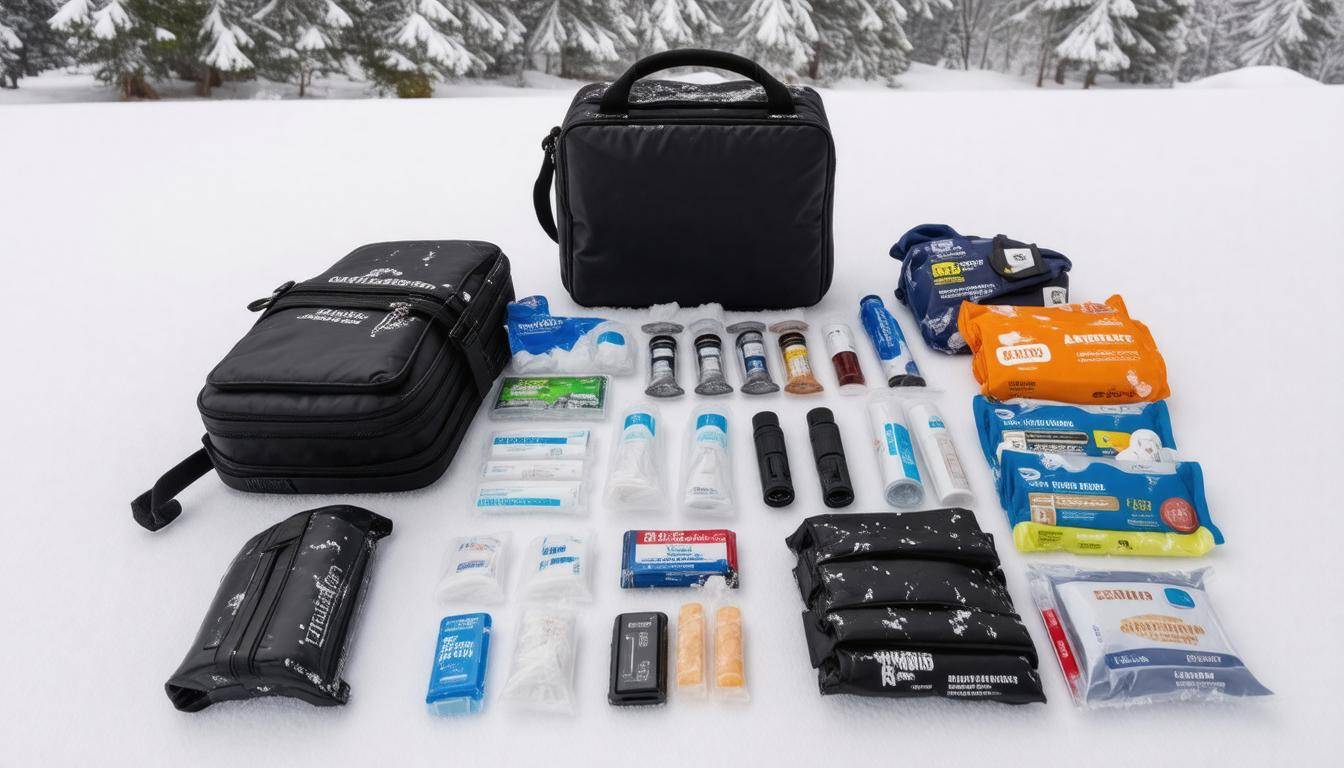
Injuries and illnesses can turn dire quickly in freezing conditions, making a well-stocked first aid kit an invaluable asset. Having a comprehensive kit does more than just cover the basics; it’s your lifeline during unexpected situations when help may be miles away. You want to have everything necessary to manage injuries or ailments that could threaten health or safety.
Comprehensive First Aid Kit
A thorough first aid kit should include essentials like adhesive bandages, sterile gauze pads, and antiseptic wipes. These items are crucial for treating cuts and scrapes to prevent infections. Additionally, pain relievers such as ibuprofen or acetaminophen can alleviate discomfort from minor injuries or cold-related pain.
A trauma kit for larger injuries—such as those from a car accident—should not be overlooked. This can include items like splints, tourniquets, and larger dressings. When selecting your supplies, consider specific risks you might encounter, especially accidents involving icy conditions where a slip could lead to sprains or fractures.
Prescription Medications
Be mindful of personal health needs; don’t forget vital prescription medications if you require regular doses. Whether it’s medication for asthma or heart conditions, having these readily available can mean the difference between safety and distress during an emergency. Packing an extra supply in case of unforeseen delays is always wise.
Emergency Blanket
An emergency thermal blanket is crucial for treating mild hypothermia, as it helps retain body heat. These blankets are lightweight and easily foldable, taking up minimal space in your vehicle while providing significant benefits in dire situations. When bundled with layers of clothing, these blankets can keep you warm until recovery becomes possible. Remember: hypothermia symptoms can escalate quickly; rapid intervention is key.
Instruction Manual
Adding a first aid manual to your emergency kit provides step-by-step instructions for treating various conditions. This guide shouldn’t only cover common ailments; it should also address severe incidents specific to cold-weather environments and scenarios unique to Alaskan winters. During stressful moments, having clear and concise instructions accessible ensures effective treatment when needed most.
Equally vital is ensuring your vehicle is well-prepared for the Alaskan winter, as this readiness complements your approach to addressing potential health issues.
Vehicle Preparation Essentials
Having a winter-ready vehicle is essential in preparing for those unpredictable Alaskan winters, especially when every second counts during an emergency. One of the first steps to take is pre-winter servicing. Before snow begins to fall, ensure your vehicle is serviced properly. This means consulting with a trusted mechanic to check antifreeze levels so that your engine doesn’t freeze, inspecting tire quality for tread and air pressure, and testing your battery condition since cold weather can sap battery power more quickly than usual.
Snow Tires
Consider investing in snow tires, as these specialized tires provide significantly better traction on icy roads compared to all-season variants. The right tires can make the difference between a smooth ride and being stuck somewhere cold and isolated. The softer rubber composition remains effective even in frigid temperatures, allowing for improved grip and handling.
Emergency Gear
Beyond the basics, it’s crucial to equip your vehicle with comprehensive emergency gear. Items such as jumper cables can help if your battery dies, while tire chains will give you added traction on slippery surfaces. A sturdy shovel becomes invaluable should you find yourself snowed in or stuck in a ditch. Meanwhile, a bag of sand or kitty litter can be used to improve traction if your tires start spinning in the snow.
Vehicle Emergency Kit
“My vehicle’s emergency kit saved me during a sudden blizzard— the jumper cables were particularly crucial,” said Alaskan driver Jane Smith. Having essential tools and supplies not only alleviates stress during emergencies but also enables you to handle situations with confidence. Remember to include items like a first aid kit, reflective vests for visibility, snacks to maintain energy levels during long waits, and even a flashlight or headlamp for when visibility fades as night approaches.
As we equip our vehicles for the unique challenges posed by winter weather, understanding how to stay safe on the road becomes paramount.
Safety Tips for Harsh Conditions
The mantra of “stay put” might sound simple, but it can be life-saving when you’re stranded in cold weather. Your vehicle becomes a refuge where you can shield yourself from the elements. Remaining with your car allows rescuers to locate you much more easily since cars are larger and often more visible than a person wandering through the vast wilderness. You have all your essentials inside the vehicle, including warmth and protection from wind. Keep the windows cracked slightly for ventilation, but layer any blankets or jackets you’ve packed to help retain warmth.
As you prepare to face the cold, layering your clothing effectively can make a significant difference in maintaining your body heat.
Layering and Hydration
Dressing in layers is not just a fashion choice; it’s a strategic plan that helps trap heat close to your body. Start with a moisture-wicking base layer that sits next to your skin, which will draw sweat away during physical exertion. Next, add an insulating layer made of fleece or wool to keep that trapped heat around you. Finally, finish with a waterproof and windproof outer shell to fend off biting cold and any snow or rain.
On top of this, don’t forget accessories! Hats, gloves, and thick socks are essential as they prevent precious body heat from escaping through exposed skin.
Staying hydrated is equally crucial; water is your friend during these long waits for assistance. Avoid consuming snow directly, as it may cool your core temperature instead of warming you up—unless it’s melted down first! Carry enough drinking water to last until help arrives.
Just as it’s important to remain hydrated and warm, keeping loved ones informed plays a vital role in your winter preparedness plans.
Regular Check-ins
Informing family or friends of your travel plans creates a safety net around your routines. Text them details like intended routes, stops along the way, and expected times of arrival. If anything goes awry—like being stranded—you provide them with key pieces of information should they need to initiate a search for you. It lends an added layer of security on top of your emergency kit, ensuring someone is aware if things do not go according to plan.
Safety Tips
Here are some quick reminders for being safe during harsh winter conditions:
- Stay with your vehicle if stranded.
- Dress in layers to retain body warmth.
- Stay hydrated; carry enough water.
- Keep loved ones informed about travel routes and expected returns.
Alaskan winters present mighty challenges characterized by frigid temperatures and unyielding snowfalls. However, armed with knowledge about staying safe and prepared can transform those challenges into manageable situations, allowing you to navigate even the toughest conditions with confidence.
What first aid supplies should be included in an Alaska winter survival kit?
An Alaska winter survival kit should include essential first aid supplies such as adhesive bandages, antiseptic wipes, gauze pads, medical tape, tweezers, a cold pack, and pain relievers like ibuprofen or acetaminophen. In extreme conditions, injuries from slips on ice or frostbite can occur frequently; the American Academy of Orthopaedic Surgeons reports that slips and falls account for nearly 25% of all non-fatal injuries. Being prepared with proper first aid supplies can drastically improve response times in emergencies and ensure safety during Alaskan winters.
How should I customize my winter survival kit based on specific activities (e.g., hiking, snowmobiling)?
To customize your winter survival kit for specific activities like hiking or snowmobiling, consider the unique challenges each presents. For hiking, prioritize lightweight gear such as a compact first-aid kit, thermal blankets, and water purification tablets since you may be carrying everything on your back. In contrast, for snowmobiling, include items like extra fuel, spare parts for equipment, and a larger food supply since you’re traveling at higher speeds and covering greater distances. Statistically, over 50% of winter-related accidents occur during outdoor activities; thus, tailoring your kit to your chosen adventure can significantly enhance your safety and preparedness.
Are there any particular foods or drinks that are recommended for a winter survival situation?
In a winter survival situation, it’s crucial to prioritize high-calorie foods and beverages that provide sustained energy and warmth. Recommended items include nuts, energy bars, dried fruits, jerky, and instant soups, as they are lightweight, non-perishable, and calorie-dense—essential for maintaining body heat in extreme cold. Studies show that during cold exposure, our bodies can burn up to 30% more calories, making it vital to consume around 4,500 to 5,000 calories daily when engaging in strenuous activities in frigid conditions. Hot drinks like cocoa or herbal tea can also provide comfort and warmth while keeping hydration levels up.
How can I ensure that my winter survival kit remains functional and accessible at all times?
To ensure your winter survival kit remains functional and accessible at all times, regularly check and update its contents every season, replacing expired items and ensuring proper functionality of gear, such as flashlights and emergency radios. A study shows that 60% of people do not maintain their emergency kits, which can lead to critical failures when they are needed most. Additionally, store the kit in a designated, easily reachable location in your vehicle or home to enhance accessibility during an emergency.
What items are absolutely essential for an Alaska winter survival kit?
An essential Alaska winter survival kit must include a reliable thermal sleeping bag rated for extreme temperatures, high-calorie food rations, a multi-tool or knife, fire-starting materials, and layered clothing for warmth. Additionally, navigation tools such as a map and compass are crucial since GPS can fail in remote areas. According to the Alaska Health Systems, hypothermia risks significantly increase with prolonged exposure to temperatures below 50°F (10°C), emphasizing the importance of proper gear to prevent life-threatening situations.
